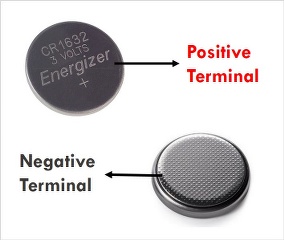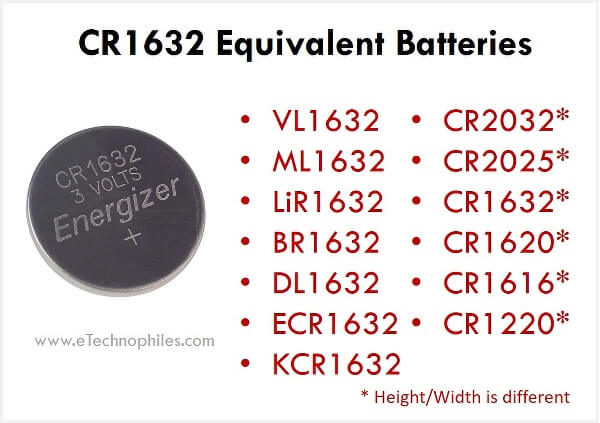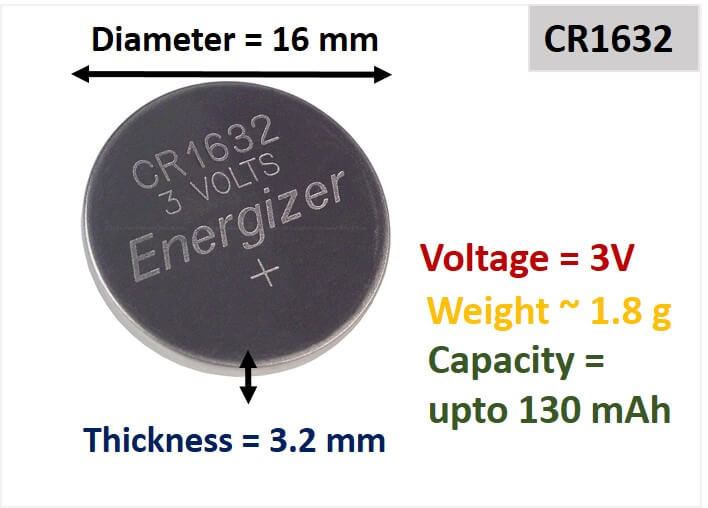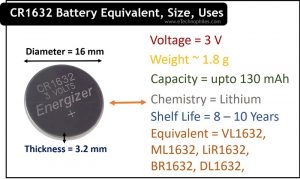Last updated on April 3rd, 2024 at 04:15 pm
CR1632 is a popular non-rechargeable coin cell made of Lithium and manganese dioxide. It has a nominal voltage of 3V, up to 130 mAh capacity, weighs 1.8 g, and is 16 mm in diameter and 3.2 mm in height.
It has a shelf life of 10 years when stored at room temperature which decreases to 5-6 years when stored at high temperatures. Its exact equivalents are(same dimensions and voltage) BR1632, DL1632, ECR1632, and KCR1632.
Although it is small in size, it provides high capacity and long shelf life. Hence these batteries have a high weight-to-power ratio.
They also maintain a stable voltage level while discharging. And are capable of functioning in a wide range of temperatures, free from electrolyte leakage.
Note: Earlier these batteries were manufactured using harmful elements like mercury and silver. But now, these elements are replaced with lithium and manganese dioxide.
Table of Contents
What does CR1632 stand for?
- The letter C indicates the chemical composition of the battery (here ie, lithium chemistry)
- The letter R indicates the shape of the battery (here ie, Round)
- The first two digits indicate the battery’s diameter in millimeters (here ie. 16mm)
- The second two digits indicate the battery’s thickness (here ie. 3.2mm)
The negative terminal is lithium and the positive terminal is manganese dioxide.
Although the battery is symmetric on both sides, it is easy to determine the positive and negative terminal. The rough texture end is the negative terminal and the opposite flat surface is the positive terminal which is indicated on the battery as ‘+’.

CR1632 equivalent batteries

The CR1632 can be easily replaced with battery VL1632, ML1632, LiR1632, BR1632, DL1632, ECR1632, KCR1632, KECR1632, KL1632, and L1632.
Here, it is evident that only the alphabets are different. The last four numerals are the same. Hence all these equivalents are replaceable with CR1632 but they differ in performance.
Note: The other chemistries may not offer the same features as the lithium-manganese dioxide chemistry. So it is necessary to verify the device’s power requirements before using an equivalent in the place of a battery.
Some other equivalent batteries are CR2025, CR2032, CR1620, CR1616, CR1220, and CR1216. But keep in mind that you will have to make some mechanical adjustments to use one of these in place of CR1632 as the dimensions are different.
Applications
Since it is a small-sized battery, they are highly utilized for small portable devices. Small medical devices are also included in the list. The popular applications of this coin cell are:
- Wireless doorbell for the house.
- Electronic Toys
- Digital thermometers
- Digital altimeter
- Cyclo-computers
- Heart rate monitors
- Watches
- small PDA devices
- Wireless doorbell
- cholesterol testing meters
- blood glucose monitors
- remote keyless entry systems
- swing and sliding gates
Specifications

The table lists the important features of this battery.
| Chemistry/ Composition | Lithium |
| Voltage | 3V |
| Diameter | 16 mm |
| Thickness | 3.2 mm |
| Weight | 1.8g |
| Capacity | Approx. 130 mAh |
| Operating temperature | Approx. -30°C to 60°C |
| Shelf life | Approx. 10 years |
You can find more information about this coin cell in its datasheet.
What are the safety concerns of the CR1632 battery?
A few safety concerns for these batteries are given below:
- Swallowing by children. Since these are tiny batteries, there are chances of swallowing by children. If that happens, take emergency medical assistance immediately. Because the chemicals in these batteries will leak and cause burns that can even cause death.
- Leakage or fire due to overheating The risk of chemical leakage is higher if the battery operates at high temperatures. Overcharging can also cause the temperature to increase. This eventually leads to fire, burns, and explosions.
- Other causes for leakage These are the other reasons that cause battery leakage:
- Keeping the battery in the idle devices for long periods
- Dropping the battery
- Using the battery after its expiry date
FAQs
Is the CR1632 battery rechargeable?
No, they are not rechargeable. Since these batteries follow lithium chemistry, they are often mistaken as rechargeable. But they are not.
The forceful recharge of these batteries will lead to leakage and explosion that can damage the connected device and even cause life threats.
How do I safely dispose of coin cells?
The chemical composition of batteries decides how they should be disposed of. Since CR1632 follows lithium chemistry, they are disposed of separately. Proper disposal not only helps in effective recycling but also ensures that the chemicals leaked from the battery do not harm the surroundings.
How long does the CR1632 battery last?
The storage temperature and environment directly affect the shelf life. For example, if we store the battery in optimal conditions, it can achieve a shelf life of up to 10 years.
Storing this cell in its original packing, a temperature range of -20℃ and 60℃, and a humidity range of 35% and 75% are some of the optimal conditions to attain maximum shelf life.
